Whenever Aldi introduces new gluten free products, they seem to ignite a good amount of curiosity. We get more requests to review Aldi gluten free foods compared to any other specific diets such as keto or dairy free. While my family does not need to eat a gluten free diet, we’re usually happy to try some of the gluten free options at Aldi, and we’ve found many of them to be pretty delicious.
Aldi sells a small selection of gluten free foods year round, and that includes brownie mix, white bread, General Tso’s chicken, chicken nuggets, pancake and baking mix, and a fantastic cornbread mix.
Aldi also rotates additional gluten free products onto its shelves for a limited time. These are often seasonal or holiday foods, or they might be short-time specials that Aldi is testing in order to determine whether to stock them more often. Because Aldi is a small-inventory grocery store, they don’t have the shelf space to stock as many products as a traditional large grocer, so they are strategic in stocking the products that sell the most. Some of the limited-edition gluten free foods I’ve seen Aldi sell over the years include English muffins, egg rolls, donuts, and stuffing mix.
Recently, I found some gluten free pizza dough at Aldi. Pizza dough reviews are some of the more popular posts we write at Aldi Reviewer, and my family loves homemade or semi-homemade pizza, so it’s nice to see that Aldi is testing a pizza dough for the gluten free crowd.
liveGfree Gluten Free Pizza Dough cost $3.49 for a 12-ounce package at the time of publication. The package states this is “ready to roll out & load with your favorite toppings for a delicious gluten free meal.”
At the time of writing, this is an Aldi Find, so it’s only in stores for a short time. Each store gets one shipment, and after that sells out, it’s gone unless Aldi decides to bring it back at some point. Aldi does not offer online ordering for products that are not in stock at your local store, so if you can’t find it on the shelves, you’re out of luck.
I found this in the Aldi Find freezer aisle at my local store, but when it’s in stock you might also find it in the refrigerated section. The package says to keep it refrigerated or frozen.
This is certified gluten free by the Gluten Intolerance Group.
Ingredients include a whole ancient grain flour blend that contains potato starch, tapioca starch, whole grain millet flour, xanthan gum, sea salt, whole grain flour, and whole grain ivory teff flour. This dough also contains water, extra virgin olive oil, apple cider vinegar, sugar, salt (salt, yellow prussiate of soda), and active dry yeast (yeast, sorbitan monostearate).
One serving (which is 1/6 of the pizza crust) has 150 calories, 4.5 grams of total fat (6% DV), 0.5 grams of saturated fat (3% DV), 350 mg of sodium (15% DV), 28 grams of total carbohydrates (10% DV), less than 1 gram of dietary fiber (2% DV), 3 grams of total sugars, and 3 grams of added sugars (6% DV). Naturally, you’ll adjust the calories and nutrition information depending on what toppings you put on your pizza.
The package has preparation instructions, saying to first preheat your oven to 450 degrees (if in an elevated climate, adjust to 475 degrees). Cover your work area and dough with gluten free flour. Roll or knead the dough into your desired crust size. Top with your favorite sauce and toppings. Then bake on the middle rack for 16-20 minutes. Do not place the pizza directly on the oven rack. Allow pizza to cool slightly before slicing.
I made this into a traditional pizza topped with Classico brand gluten free pizza sauce and Aldi shredded mozzarella, and I put pepperoni on half of it. I followed the directions on the package exactly, covering the baking sheet with a generous amount of flour when I rolled the dough out.
I baked the pizza for 15 minutes. During baking, some large bubbles formed in the dough and I poked them down some with a fork. Still, because the dough kept bubbling up, some of the cheese on that side of the pizza ended up well done. If I made this pizza dough again, I might poke the rolled-out dough with a fork a few times before adding toppings and baking, as that is what the instructions recommend when I make homemade traditional pizza crust following the recipe on the back of the Aldi yeast packets.
Other than some areas with darker cheese because of bubbling during baking, the pizza looked great when I pulled it out of the oven. I let it cool for a few minutes and then went to slide it off my nicer baking sheet onto an old baking sheet to slice it … and it stuck to the nice baking sheet, badly.
I spent several minutes fighting with a spatula to loosen the stuck pizza from the baking sheet, and some of the crust stayed stuck on the baking sheet.
As for how the pizza tasted, it was great. My family happily ate it, and we couldn’t tell any difference between this and traditional pizza dough made with wheat flour. This dough will definitely give you your pizza fix, or you could use it to make calzones or other pizza-type meals.
If I buy this again, I would spray the baking sheet with cooking spray before putting the dough on. Some readers may fuss and insist you aren’t supposed to use any kind of oil on your pizza pan, but the pizza recipe on the Aldi yeast packet does recommend greasing the pan. Also, some readers have pointed out in comments on our review of regular, gluten-containing Aldi refrigerated pizza dough that certain types of pizza pans do indeed get greased, including pan-style pizzas.
The Verdict:
liveGfree Gluten Free Pizza Dough makes a great-tasting pizza that tastes as good as traditional semi-homemade pizzas we’ve eaten. However, be aware that this pizza sticks badly to whatever pan you bake it on. The package directions do not say to grease the pan — only to put gluten free flour on it — but just know that flour alone probably won’t keep this pizza from getting stuck. We had to spend several minutes fighting to get our pizza unstuck from the pan, and some of the bottom crust tore off and remained stuck on the pan.

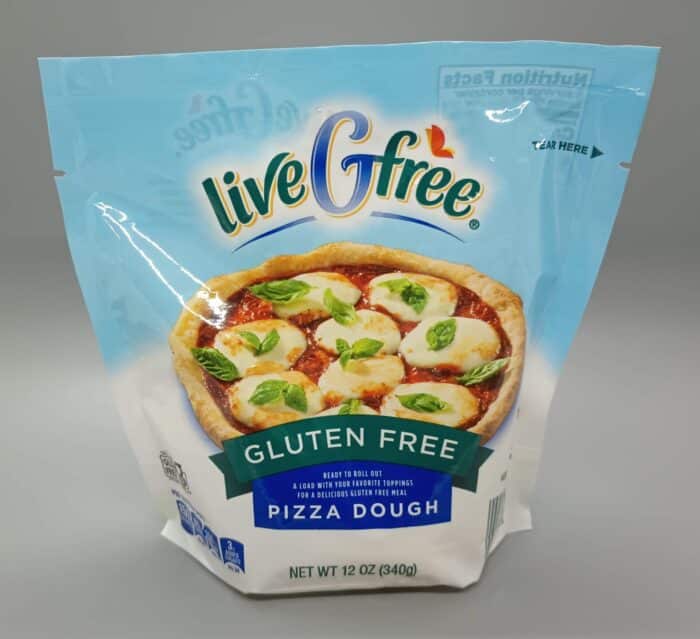
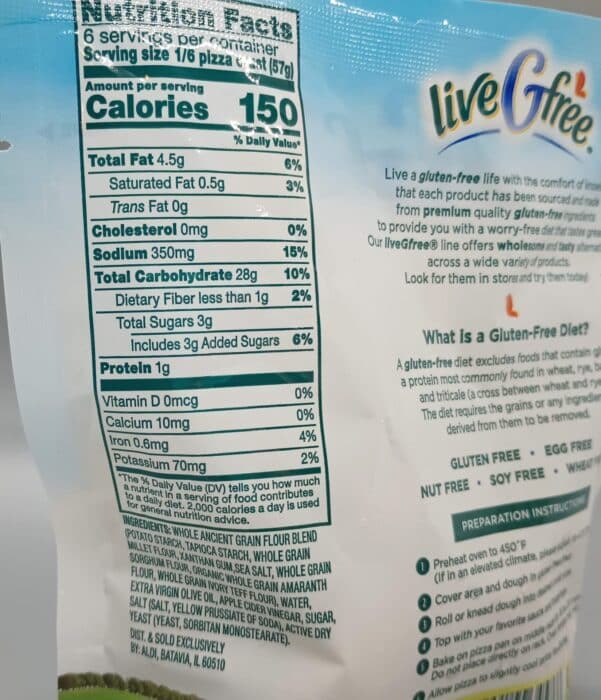
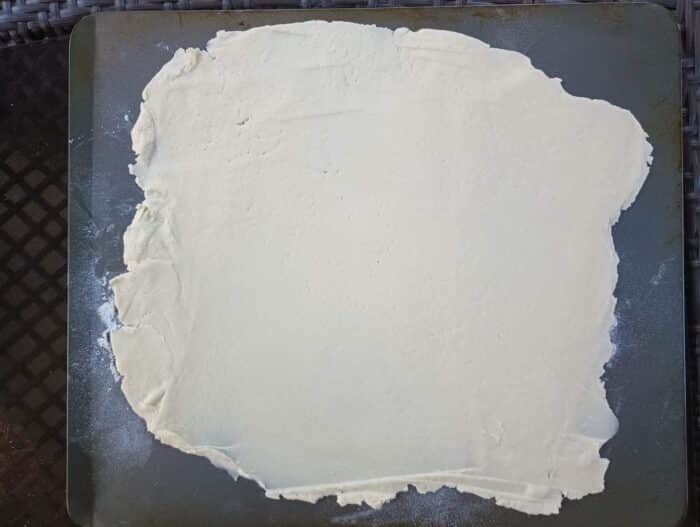
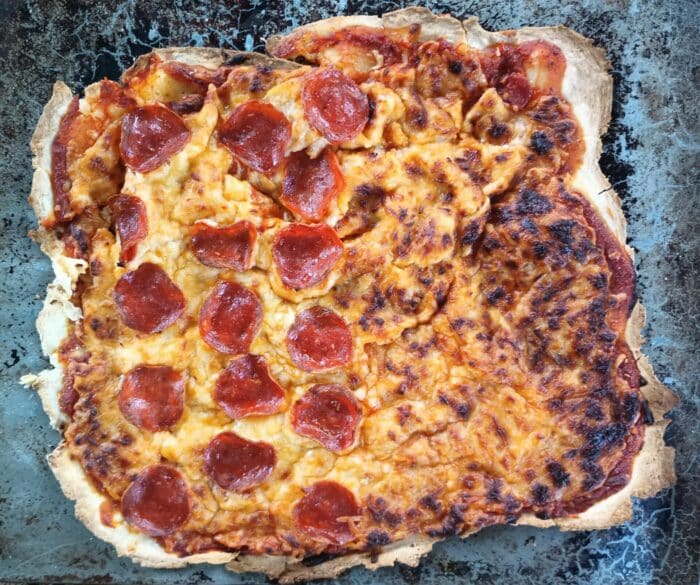
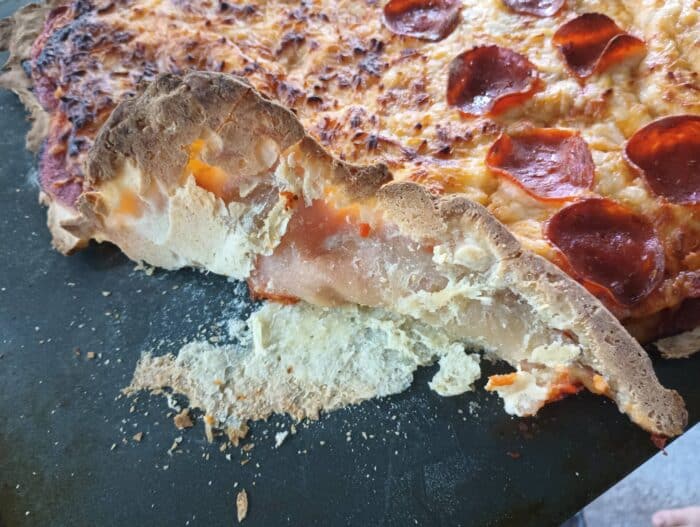
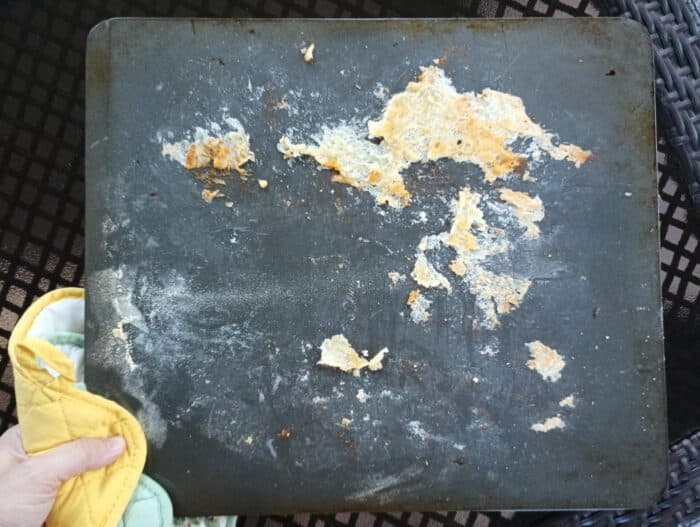

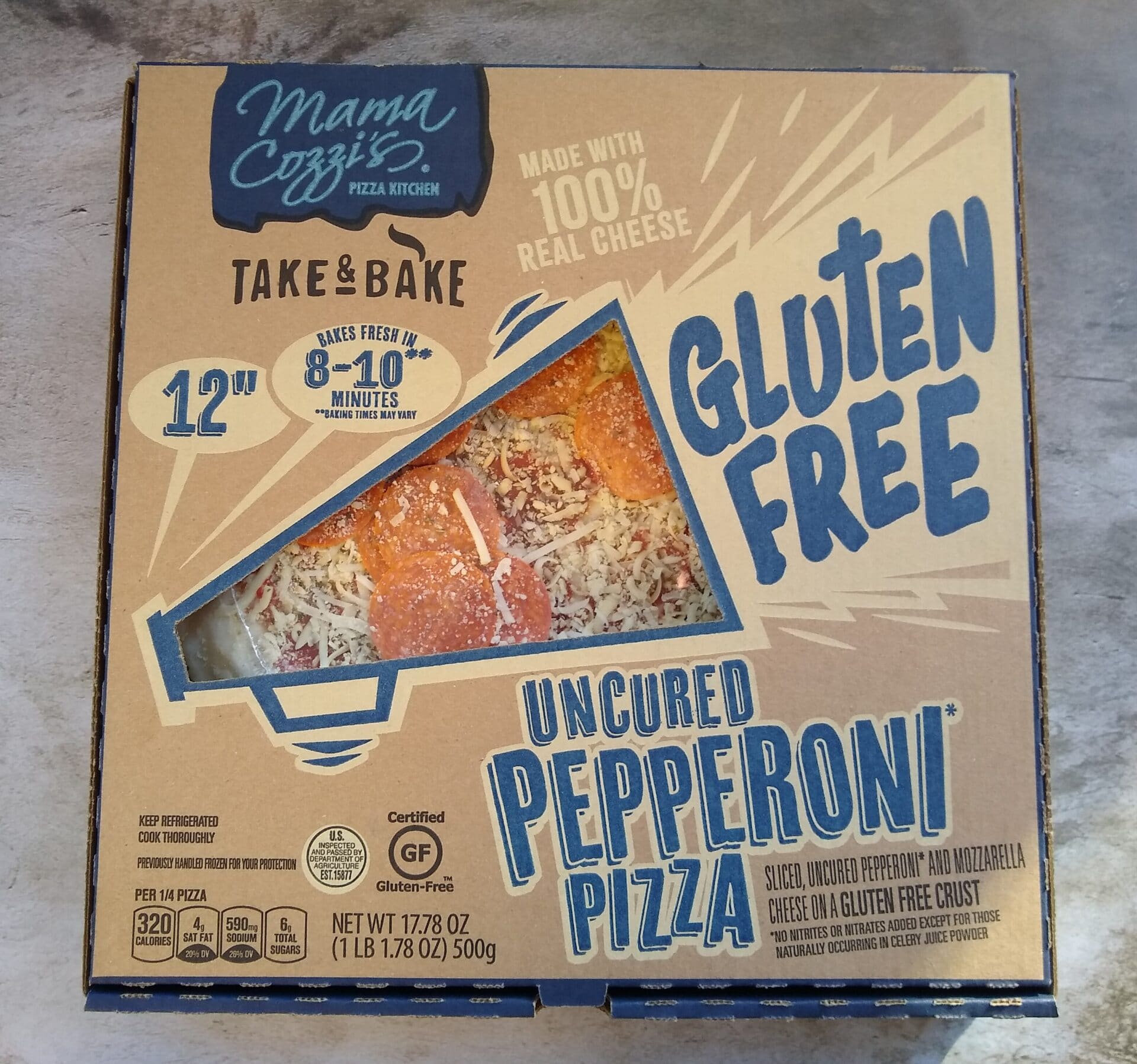
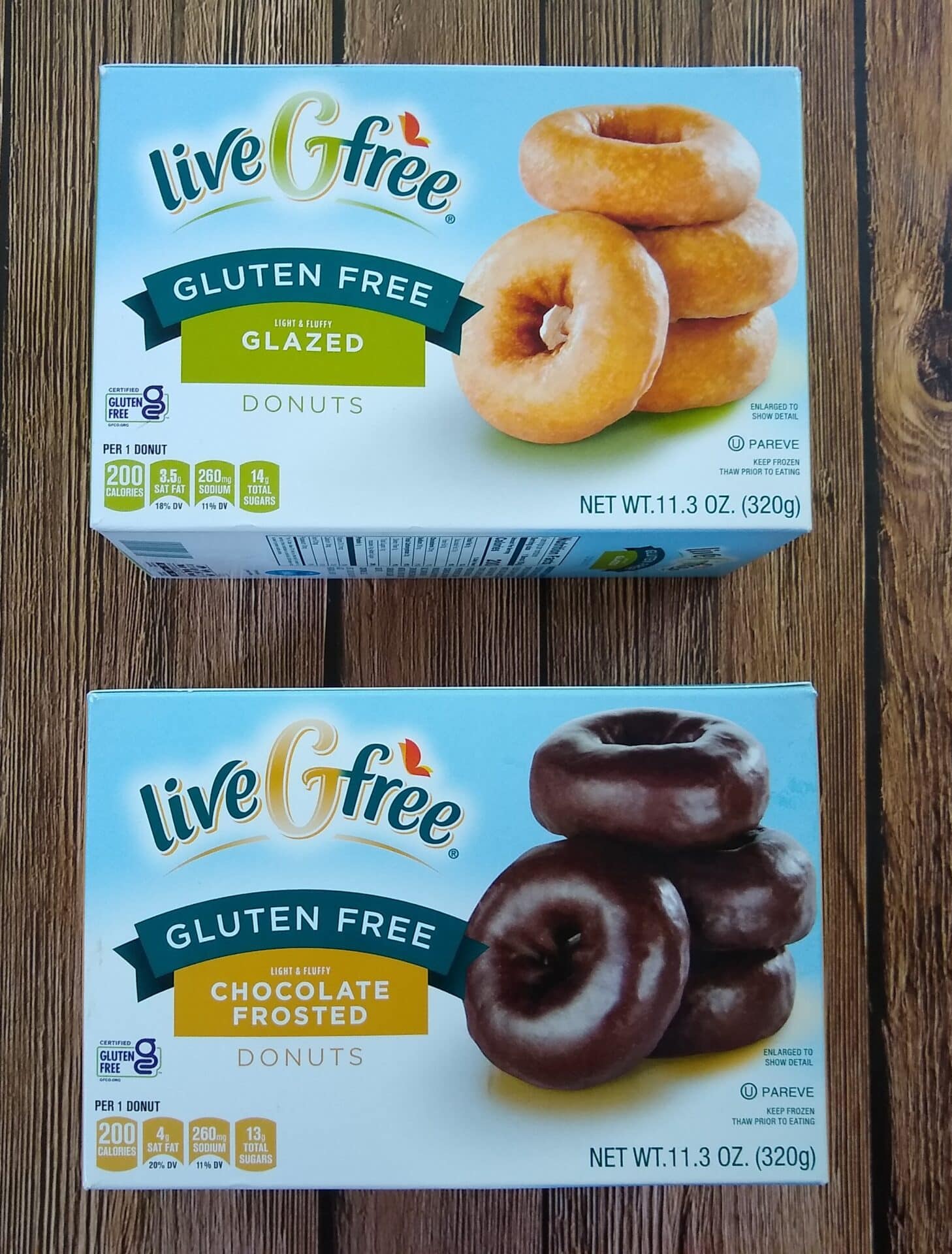
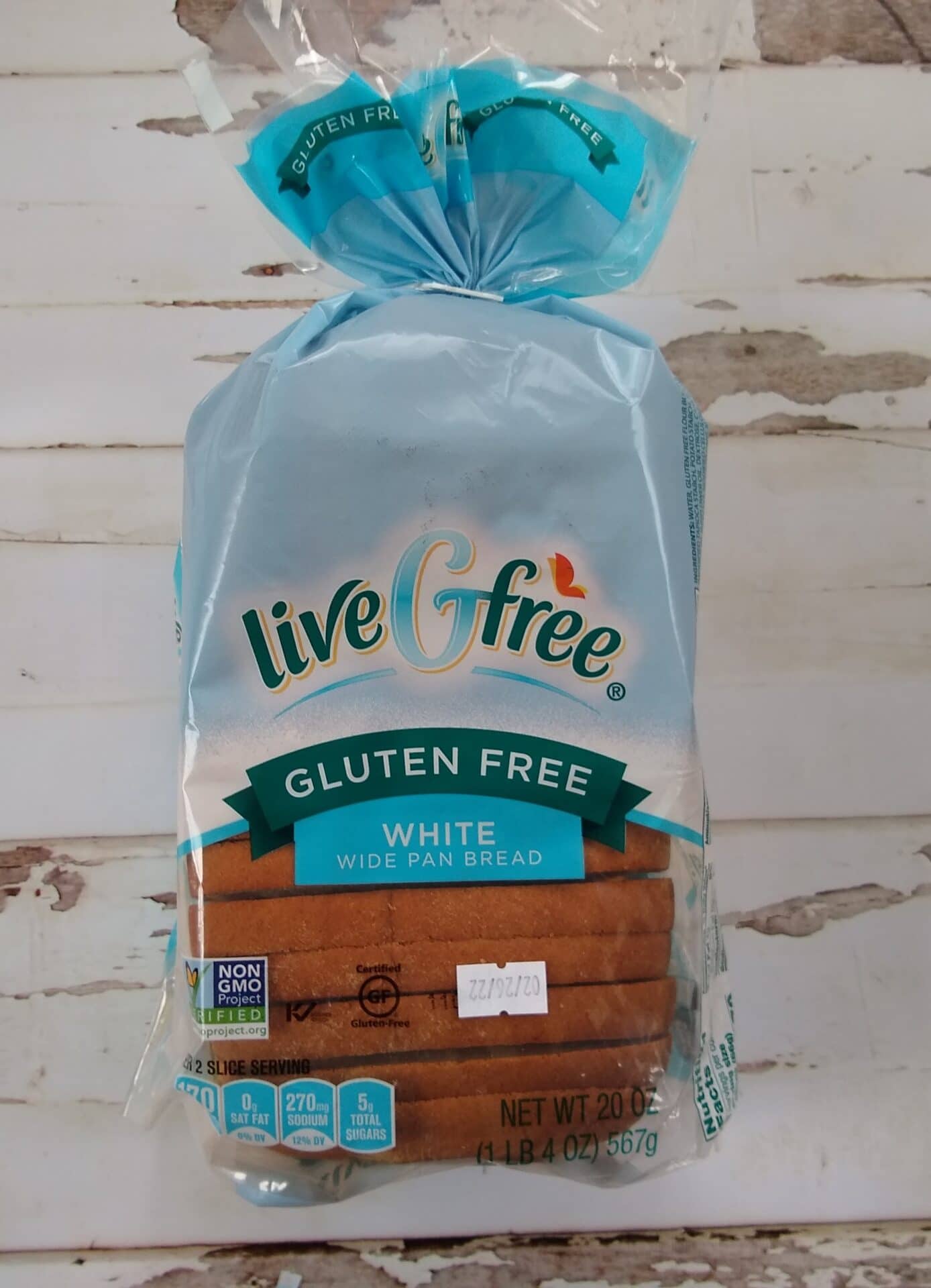
Hi Rachel, try cornmeal sprinkled on the baking sheet instead of flour.
This is what I did to bake on a cast iron griddle pan. The corn meal worked perfectly, and the pizza slid right off.
I use parchment paper, put EVOO on it and then the dough ball and coat hand with EVOO and press it instead of rolling. Works great (just got this… But this is how I make Wholly wholesome dough!
I like the idea of using parchment paper because I always have that in my kitchen.
I really do wish the directions on the packaging addressed the issue of the cooked pizza dough sticking, though. I ought to be able to follow the directions exactly as they’re printed and not have problems.
I could be wrong, but it appears you have rolled the dough when it was on the pan. If so, may I suggest rolling it on the counter sprinkled with g.f.flour and then transfer it to the pan.
I might have to try that next time. Thanks for the tip.
Rachael, I tried this pizza crust for the first time today. I made sure to roll it out on the counter with g.f. flour. I was able to fold it in half, then half again like a pie crust. It baked perfectly. It did not stick at all. I did forget your warning about piercing it with a fork and it was quite huge !! Very funny looking. But anywho, it worked well for me. I appreciate your review and will buy this dough again.
Thanks for sharing! Glad it turned out well!
Thanks for this review! Has anyone tried to make a Stromboli with this dough?
We’ve made two pizzas now using this dough. My son loves this crust! I lay down parchment on my counter top, flour it and roll out the dough on the parchment (no added oil or cornmeal necessary). Then I transfer the parchment to my pizza pan for baking. The pizza easily comes off the parchment when it’s done in the oven!
We are so happy with this product and hope they decide to keep it around. In the meantime, I purchased several and threw them in my freezer!
This pizza gluten free dough is excellent I wish they keep bringing it back. Love love love it